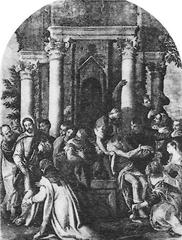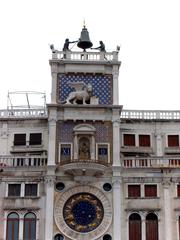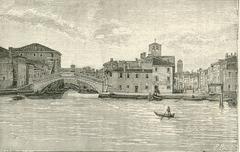
Chioggia Cathedral Visiting Hours, Tickets, and Travel Guide
Date: 04/07/2025
Introduction to Chioggia Cathedral and Its Historical Significance
Situated in the heart of Chioggia, within the Venetian Lagoon, the Cathedral of Santa Maria Assunta (Chioggia Cathedral) is a profound emblem of faith, resilience, and artistic achievement. Its origins stretch back over a millennium, with the earliest church established during the 8th century as a sanctuary for those fleeing barbarian invasions. Over the centuries, the cathedral evolved alongside the city, reflecting Chioggia’s transformation into a maritime and religious hub. The original medieval basilica, built in the “Ravenna” style, was tragically destroyed by fire in 1623. Its Baroque reconstruction, led by the renowned architect Baldassare Longhena, introduced Venetian elegance and classical elements to the cityscape (Wikipedia; Lidi di Chioggia).
Today, Chioggia Cathedral is celebrated not only for its striking architecture but also for its significant artworks, including altarpieces by Jacopo Palma the Younger, a Callido organ, and intricate marble pulpits. The structure’s red brick façade, statues of patron saints Felice and Fortunato, and the adjacent 14th-century Romanesque bell tower are central features within the city’s historic center. The cathedral continues to play a vibrant role in Chioggia’s religious and cultural life, hosting major ceremonies and anchoring a neighborhood rich with canals, markets, and historic landmarks (JustInPlusLauren; Visit Chioggia).
For travelers, the cathedral is open daily with free admission, and guided tours are available through local operators. Its accessible facilities, deep-rooted history, and proximity to other attractions make Chioggia Cathedral a must-see in the Veneto region (cattedralechioggia.it; Italy This Way).
Guide Contents
- Early Foundations and Medieval Origins
- Fire of 1623 and Baroque Rebuilding
- Architectural Features and Artworks
- Religious and Civic Importance
- Visitor Information
- Visiting Hours & Tickets
- Accessibility
- Health Guidelines
- Travel Tips and Nearby Attractions
- Diocesan Museum and Artistic Collections
- Restoration and Preservation
- Frequently Asked Questions (FAQ)
- Plan Your Visit
Early Foundations and Medieval Origins
The Cathedral of Santa Maria Assunta has anchored Chioggia’s religious life since at least the 8th century, serving as a sanctuary during times of upheaval (Wikipedia; Italy This Way). By around 1000 AD, a larger basilica in the “Ravenna” style was built, featuring a long nave, two aisles, and a semi-circular apse. This structure, measuring roughly 63 meters by 45 meters, was a symbol of Chioggia’s growing prominence in trade and religion.
Despite repeated conflicts, including the 14th-century war between Venice and Genoa, the cathedral remained central to Chioggia’s identity, withstanding the test of time and serving as both a spiritual and civic anchor (Italy This Way).
The Catastrophic Fire of 1623 and Baroque Rebuilding
On the night of December 25–26, 1623, a fire—believed to be arson—devastated the medieval cathedral, destroying priceless artifacts and leaving the community without its spiritual core (Wikipedia). Reconstruction began almost immediately under Baldassare Longhena, a master of Venetian Baroque architecture. Completed in 1627, the new design merged Corinthian and Ionic elements, marking a stylistic evolution for Chioggia and demonstrating the community’s resilience (Lidi di Chioggia; JustInPlusLauren).
Architectural Features and Artistic Heritage
The cathedral’s exterior is defined by its austere red brick façade, flanked by statues of Saints Felice and Fortunato. A 14th-century bas-relief of the Madonna with Child and the city’s patron saints is preserved above the main portal. The adjacent Romanesque bell tower, dating from 1347, is one of Chioggia’s oldest and most recognizable landmarks (JustInPlusLauren).
Inside, the cross-shaped layout features three aisles with semi-columns and six side altars adorned with works by Jacopo Palma the Younger, Francesco Rosa, and others (Lidi di Chioggia). Key highlights include the baptistery (early 18th century), a beautifully carved marble pulpit by Bartolomeo Cavalieri (1677), and an impressive Callido organ with over 1,600 pipes (Visit Chioggia).
Religious and Civic Importance
As the seat of the Bishop of Chioggia, the cathedral has always been the city’s main place of worship and a focal point for major religious events (Pineqone). Its location, near Chioggia’s heart, underscores its civic significance. The nearby Refugium Peccatorum statue and the tradition of praying for those at sea highlight the deep connection between faith and daily life in Chioggia (JustInPlusLauren; Mama Loves Italy).
Practical Visitor Information
Visiting Hours & Tickets
- Hours: Generally open daily from 9:00 AM to 12:00 PM and 3:00 PM to 6:00 PM; hours may vary seasonally or during special events.
- Admission: Free; donations are appreciated for maintenance. Guided tours may carry a fee and can be arranged via local tourism offices.
Accessibility
- Wheelchair accessible, with ramps at entrances and accessible restrooms available.
- Assistance for visitors with mobility challenges is offered—contact the cathedral in advance for arrangements.
Health Guidelines
- Check current health protocols before visiting, as mask-wearing or capacity limits may be in effect.
Travel Tips and Nearby Attractions
The cathedral is centrally located, making it an ideal starting point for exploring Chioggia’s historic center. Notable nearby sites include the Vigo Bridge, Sant’Andrea Clock Tower (with the world’s oldest functioning clock), the bustling fish market on Corso del Popolo, and the scenic canals (Visit Chioggia). Public transport connects Chioggia with Venice and lagoon towns, and parking is available near the historic center.
Diocesan Museum and Artistic Collections
Adjacent to the cathedral, the Diocesan Museum displays original artworks, liturgical objects, and relics, offering deeper insight into the religious and artistic history of Chioggia (cattedralechioggia.it). The museum enhances the visitor experience for those interested in sacred art and local heritage.
Restoration and Preservation
Ongoing restoration efforts—such as the 2013 stained glass window and statue conservation—ensure the cathedral’s preservation. These activities reflect Chioggia’s commitment to safeguarding its cultural legacy (Italy This Way).
Frequently Asked Questions (FAQ)
Q: What are the cathedral’s visiting hours?
A: Typically, 9:00 AM to 12:00 PM and 3:00 PM to 6:00 PM daily. Check for updates during holidays and special events.
Q: Is there an entrance fee?
A: No, entry is free. Donations are welcome.
Q: Are guided tours available?
A: Yes, through local tourism offices or with advance booking.
Q: Is the cathedral accessible for people with disabilities?
A: Yes, with ramps and accessible restrooms.
Q: What other attractions are nearby?
A: Vigo Bridge, Sant’Andrea Clock Tower, the fish market, and Diocesan Museum.
Enhancing Your Visit: Local Life and Seasonal Tips
Chioggia’s vibrant atmosphere is shaped by its canals, bridges, and markets. The Corso del Popolo, lined with Venetian architecture and lively cafés, leads visitors to the cathedral (affittibreviveneto.com). Local festivals, culinary traditions, and the city’s “Little Venice” ambiance add to the experience (mykindofitaly.com). The best times to visit are spring and early autumn, when the weather is pleasant and crowds are manageable.
Plan Your Visit and Stay Connected
For up-to-date information on visiting hours, special events, and guided tours, consult the cathedral’s official brochure (PDF) or the Chioggia tourism portal. Enhance your experience with the Audiala app, which provides guided tours, maps, and insider tips. Follow us on social media for travel inspiration and event updates.
Summary
Chioggia Cathedral stands at the intersection of history, art, and community. From its medieval origins and Baroque reinvention to its role as a spiritual and civic heart, the cathedral encapsulates the resilience and identity of Chioggia. With free access, accessible facilities, and a wealth of nearby attractions, it offers a rewarding experience to every visitor. Ongoing preservation ensures that Chioggia Cathedral remains a living monument for generations to come (cattedralechioggia.it; Visit Chioggia; Italy This Way).
Sources and Further Reading
- Wikipedia
- Italy This Way
- Lidi di Chioggia
- cattedralechioggia.it
- JustInPlusLauren
- catholicshrinebasilica.com
- affittibreviveneto.com
- Visit Chioggia
- mykindofitaly.com





